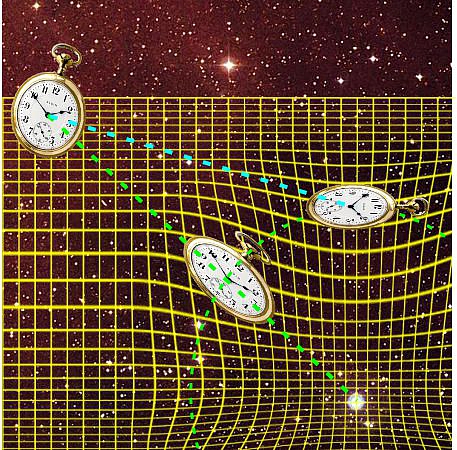<We rejoin Sy and Vinnie in the library stacks…> “Are you boys discussing me?”
<unison> “Oh, hi, Ramona.”
“Actually no, Ramona, we were discussing relativistic time dilation.”
“I know that, Sy, I’ve been reading your posts. Now I’ve got a question.”
“But how…? Never mind. Guess I’d better watch my writing. What can I do for you?”
“You and Vinnie have been going on about kinetic time dilation and gravitational time dilation like they’re two separate things, right?”
“That’s how we’ve treated them, right, but the textbooks do the same. The velocity-dependent time-stretch equation, tslow/tfast = √[1-(v²/c²)], comes out of Einstein’s Special Theory of Relativity. The gravity-dependent equation, tslow/tfast = √[1-(2G·M/r·c²)], came from his General Theory of Relativity.”
“But there’s no rule that says an object can’t be moving rapidly while it’s in a gravitational field, is there? That Endurance spacecraft orbiting the black hole in the Interstellar movie certainly seemed to be in that situation.”
“No question, Ramona. General Relativity’s just more, er, general.”
“Fine, but shouldn’t they work together?”
That got Vinnie started. “Yeah, Sy, I started this with LIGO and gravity but you and those space shuttles got me into this speed thing. How do you bridge ’em?”
“Not easily. Einstein set the rules of the game when he wrote down his fundamental equations. Physicists and mathematicians have been trying to solve them ever since. Schwarzchild found the first solution within a year after the equations hit the streets, but he did the simplest possible system — a non-rotating spherical object with no electrical charge and alone in the Universe. It took another half-century before Kerr and friends figured out how to handle rotating spheres with an electric charge, but even those objects are assumed to be isolated from all other masses. Mm … how do you figure velocity, Vinnie?”
“Distance divided by time, easy.”
“Not quite that easy. The equations say that if you’re close to a massive object, space gets compressed, time gets stretched, and the time and space dimensions get scrambled. Literally. Time near a Schwarzchild object points inward as you approach the sphere’s center, and don’t ask me how to visualize that. A Kerr object has a belt around its equator where time runs backwards. Craziness.”
“Well, how about if I’m not that close?”
“That’s easier to answer, Ramona. Suppose the three of us are each flying at safe distances from some heavy object with mass M. I’m farthest away so I’m holding the fastest clock. We’ll compare Vinnie’s and your clocks to mine. OK?”
“Sure, why not?”
“Fine. Now, Vinnie, you’re closer in, resting on the direct line between me and the object. You’re at distance r from it. How fast does your clock run?”
“Uhhh… We’re both on that same radial line so we’re in the same inertial frame, no kinetic effect. I suppose you see it ticking slower because of the gravitational effect.”
“M-hm, and my clock ticks how often between ticks of yours?”
“You want the equation, huh? All right, it’s tvinnie/tsy = √[1-(2G·M/r·c²)].”
“You’re reading my mind with those subscripts. Now, Ramona, you’re at that same distance from the object but you’re in orbit around it. Measured against Vinnie’s position you’ve got velocity v. How fast is his clock ticking compared to yours?”
“Mmm… We’re at the same level in the gravity field, so the gravitational thing makes no difference. So … tramona/tvinnie = √[1-(v²/c²)]. Aaand, he’d see my clock running slow by the same amount. That’s weird.”
“Weird but true. Last step — Ramona, you’re deeper in the gravitational field and you’re speeding away from me, so tramona/tsy=(tramona/tvinnie)*(tvinnie/tsy)=√[1-(2G·M/r·c²)]*√[1-(v²/c²)] covers both.”
“OK, that’s settled. Back to Vinnie’s original question. LIGOs are set in concrete, their velocities are zero so LIGO signals are all about gravity, right?”
“Right.”
Ramona links arms with him. “Let’s go dancing.” Then she gives me the eye. “Sugarlumps, Sy? Really?”
On the 12th floor of the Acme Building, high above the city, one man still tries to answer the Universe’s persistent questions — Sy Moire, Physics Eye.
~~ Rich Olcott


OK, Rich, tell me if I am understanding this to any degree. The closer to a massive object, the more space is compressed. Because velocity, distance and time are related, when one variable changes, then another one does to compensate. So the more space is compressed, the more time is dilated. Anyone traveling (theoretically) in space compressed to a great degree, would age slower than us on Earth. Black holes are very massive so space is extremely compressed and time is extremely dilated. Because light doesn’t vary in its speed, it can’t go fast enough in these stretched out seconds to get out. Your diagram reminds me of Salvador Dali’s famous painting, https://en.wikipedia.org/wiki/The_Persistence_of_Memory.
LikeLike
You got it, Carol. Thanks for the close read.
LikeLike